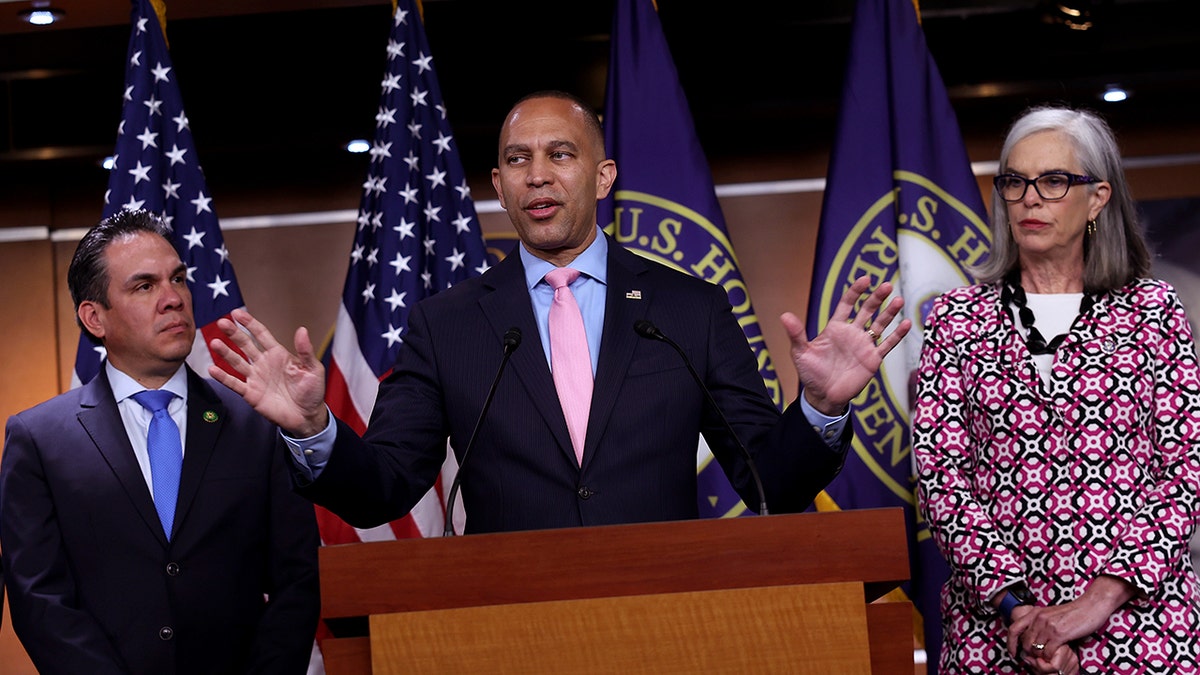Rep. Byron Donalds says Speaker Kevin McCarthy is 'in trouble'
Rep. Byron Donalds Republicans got nothing from funding deal
Rep. Matt Gaetz, R-Fla., says he will file a "motion to vacate the chair" this week.
This is an effort to force a vote of no confidence on the floor for House Speaker Kevin McCarthy, R-Calif., and potentially prompt a new vote for speaker.
Gaetz doesn’t believe McCarthy has held up his end of the bargain after the lengthy speaker vote in January. The Florida Republican threatened to use this motion if McCarthy relied on Democrats to advance spending bills. McCarthy turned to Democrats on Saturday to avert a government shutdown.
Such a gambit to try to bounce a speaker in the middle of a Congress is rare.
Former Rep. Mark Meadows, R-N.C., threatened to use the tactic on former House Speaker John Boehner, R-Ohio, in the summer of 2015. Boehner saw the writing on the wall and resigned that October.
PROGRESSIVE ‘SQUAD’ DEMOCRAT ACCUSED OF PULLING FIRE ALARM AMID TENSE SHUTDOWN TALKS

House Speaker Kevin McCarthy is under pressure from conservatives not to pass a "clean" continuing resolution. (Getty Images)
The House last saw a formal effort to remove a speaker in 1910. A number of members were displeased with House Speaker Joe Cannon, R-Ill., and found him to be too dictatorial. Cannon got in front of his adversaries, who also wanted to call for a new speaker, by offering the motion to vacate himself. Cannon survived – but with the help of the minority party.
He then became a very weak speaker.
It’s unclear if Democrats could bail out McCarthy in this scenario.
Keep in mind that McCarthy ally Rep. Garret Graves, R-La., has also filed a motion to vacate the chair. This is a protective measure that Graves could use to supersede Gaetz’s gambit. It was thought that McCarthy loyalists could try to call the bluff of Gaetz by filing their own motion first or daring Gaetz to follow through.
By rule, Gaetz’s resolution is "privileged." That means that when Gaetz offers his resolution, the House must consider it immediately or within two legislative days.
However, the vote will not immediately be on the motion to vacate the chair. It is highly probable that one of McCarthy’s lieutenants will then move to table (kill) Gaetz’s motion or make a motion to refer the effort to the Rules or House Administration Committee. So, the first vote is NOT actually on Gaetz’s motion, let alone an election of a new speaker. The vote is on the secondary motion to table or refer Gaetz’s measure to committee, not on the primary motion.
If the House approves the secondary motion to table or refer, then Gaetz’s gambit is euthanized. The gig is up.

Matt Gaetz speaks to the press outside the U.S. Capitol as the House votes on a continuing resolution on Sept. 30, 2023. (Andrew Caballero-Reynolds/AFP via Getty Images)
But if the secondary motion fails, then the House votes on the primary motion. That would be Gaetz’s motion to vacate the chair. If the secondary motion loses, the primary motion likely prevails. If the primary motion (the motion to vacate) is successful, we are back to Jan. 3, the start of the Congress. The House must take a vote – or votes – to elect a speaker.
Everything on the House floor would come to a screeching halt. The House can do nothing on the floor without electing a speaker. No legislation on the floor. However, committees can continue to meet, et al.
It took 15 rounds spread over five days to elect McCarthy the first time. It was the longest speaker election since 1859. Consider how long it could take the House to re-elect McCarthy or tap someone else as speaker.
The House must continue to vote and vote and vote until it elects a speaker. The House consumed two months in late 1855 and early 1856 before finally electing Speaker Nathaniel Banks, R-Mass., on the 163rd ballot.

"The one thing everyone seems to have in common is no one trusts Kevin McCarthy," Gaetz told reporters outside the Capitol on Saturday. (Andrew Caballero-Reynolds/AFP | Al Drago/Bloomberg)
The successful candidate must receive an outright majority of all members casting ballots for someone by name. "Present" votes do not count. Members who do not vote don’t count against the vote total.
The person with the "most votes" does not win. That’s why electing the speaker can be a rather complex piece of parliamentary algebra.
The House currently has 433 members. If all members vote for someone by name in a speaker’s race, the successful candidate must receive 217 votes.
It’s uncertain if it will get to this stage. But this entire process is about the math.
It’s unclear how many Republicans may vote against that secondary motion to table or refer. McCarthy’s move on government funding has inflamed many on the hard right.
And it’s unclear if Democrats could potentially assist McCarthy.

House Minority Leader Hakeem Jeffries speaks on the debt ceiling at the U.S. Capitol on May 31, 2023. (Kevin Dietsch/Getty Images)
Some McCarthy opponents on the Democratic side of the aisle may vote with Republicans wanting to bounce the speaker. Others may not participate in the vote at all. House Minority Leader Hakeem Jeffries, D-N.Y., has said that Republicans must solve this civil war on their own.
CLICK HERE TO GET THE FOX NEWS APP
If Democrats don’t cast a ballot on the secondary motion, that drives down the total number of ballots cast. This is where things get very dangerous for McCarthy. McCarthy allies may not have enough votes to kill the motion to vacate, thus putting that motion in play on the next roll call.
Again, if the second motion fails, the House then votes on the initial motion – the motion to vacate. If the House defeats the second motion, it probably adopts the primary Gaetz motion. And that scenario triggers an automatic revote for speaker of the House.


























